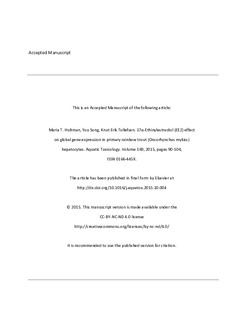| dc.contributor.author | Hultman, Maria Therese | |
| dc.contributor.author | Song, You | |
| dc.contributor.author | Tollefsen, Knut Erik | |
| dc.date.accessioned | 2018-11-13T08:36:23Z | |
| dc.date.available | 2018-11-13T08:36:23Z | |
| dc.date.created | 2015-12-22T14:18:14Z | |
| dc.date.issued | 2015 | |
| dc.identifier.citation | Aquatic Toxicology. 2015, 169, 90-104. | nb_NO |
| dc.identifier.issn | 0166-445X | |
| dc.identifier.uri | http://hdl.handle.net/11250/2572092 | |
| dc.description.abstract | The potential impact of endocrine disrupting chemicals (EDCs) in the aquatic environment has driven the development of screening assays to evaluate the estrogenic properties of chemicals and their effects on aquatic organisms such as fish. However, obtaining full concentration–response relationships in animal (in vivo) exposure studies are laborious, costly and unethical, hence a need for developing feasible alternative (non-animal) methods. Use of in vitro bioassays such as primary fish hepatocytes, which retain many of the native properties of the liver, has been proposed for in vitro screening of estrogen receptor (ER) agonists and antagonists. The aim of present study was to characterize the molecular mode of action (MoA) of the ER agonist 17α-ethinylestradiol (EE2) in primary rainbow trout (Oncorhynchus mykiss) hepatocytes. A custom designed salmonid 60,000-feature (60k) oligonucleotide microarray was used to characterize the potential MoAs after 48 h exposure to EE2. The microarray analysis revealed several concentration-dependent gene expression alterations including classical estrogen sensitive biomarker gene expression (e.g. estrogen receptor α, vitellogenin, zona radiata). Gene Ontology (GO) analysis displayed transcriptional changes suggesting interference of cellular growth, fatty acid and lipid metabolism potentially mediated through the estrogen receptor (ER), which were proposed to be associated with modulation of genes involved in endocrine function and reproduction. Pathway analysis supported the identified GOs and revealed modulation of additional genes associated with apoptosis and cholesterol biosynthesis. Differentially expressed genes (DEGs) related to impaired lipid metabolism (e.g. peroxisome proliferator-activated receptor α and γ), growth (e.g. insulin growth factor protein 1), phase I and II biotransformation (e.g. cytochrome P450 1A, sulfotransferase, UDP-glucuronosyltransferase and glutathione S-transferase) provided additional insight into the MoA of EE2 in primary fish hepatocytes. Results from the present study suggest that biotransformation, estrogen receptor-mediated responses, lipid homeostasis, growth and cancer/apoptosis in primary fish hepatocytes may be altered after short-term exposure to ER-agonists such as EE2. In many cases the observed changes were similar to those reported for estrogen-exposed fish in vivo. In conclusion, global transcriptional analysis demonstrated that EE2 affected a number of toxicologically relevant pathways associated with an estrogenic MoA in the rainbow trout hepatocytes. | nb_NO |
| dc.language.iso | eng | nb_NO |
| dc.publisher | Elsevier | nb_NO |
| dc.rights | Attribution-NonCommercial-NoDerivatives 4.0 Internasjonal | * |
| dc.rights.uri | http://creativecommons.org/licenses/by-nc-nd/4.0/deed.no | * |
| dc.title | 17α-Ethinylestradiol (EE2) effect on global gene expression in primary rainbow trout (Oncorhynchus mykiss) hepatocytes | nb_NO |
| dc.title.alternative | 17α-Ethinylestradiol (EE2) effect on global gene expression in primary rainbow trout (Oncorhynchus mykiss) hepatocytes | nb_NO |
| dc.type | Journal article | nb_NO |
| dc.type | Peer reviewed | nb_NO |
| dc.description.version | acceptedVersion | nb_NO |
| dc.source.pagenumber | 90-104 | nb_NO |
| dc.source.volume | 169 | nb_NO |
| dc.source.journal | Aquatic Toxicology | nb_NO |
| dc.identifier.doi | 10.1016/j.aquatox.2015.10.004 | |
| dc.identifier.cristin | 1303860 | |
| dc.relation.project | Norges forskningsråd: 196318 | nb_NO |
| cristin.unitcode | 7464,0,0,0 | |
| cristin.unitname | Norsk institutt for vannforskning | |
| cristin.ispublished | true | |
| cristin.fulltext | postprint | |
| cristin.qualitycode | 2 | |

